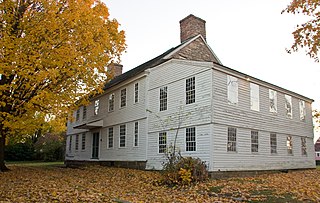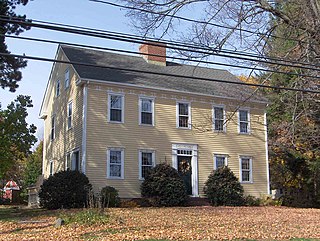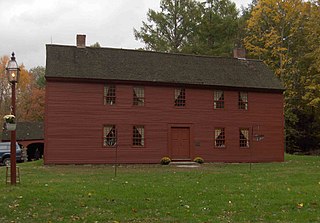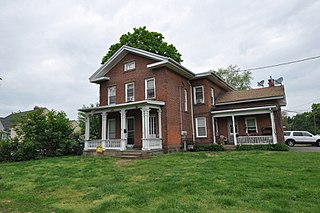
The Carpenter House, also known as the Gardiner (Gardner) Carpenter House and the Red House, is a Georgian style house in Norwichtown area of Norwich, Connecticut. A house was previously on the site, but it was removed by Gardner Carpenter to construct the house in 1793. The three-story Flemish bond Georgian house's front facade consists of five bays with a gabled porch over the main entrance and supported by round columns. The gambrel roof and third story addition were added around 1816 by Joseph Huntington. In 1958, a modern one-story rear wing was added to the back of the house. The interior of the house is a center hall plan with 10-foot (3.0 m) high ceilings and has been renovated, but retains much of its original molding, paneling and wrought iron hardware. It was listed on the National Register of Historic Places in 1970 and added to the Norwichtown Historic District in 1973.

The Jonathan Wheeler House is a historic house on North Society Road in Canterbury, Connecticut. Built c. 1760, it has features unusual for its time, including end chimneys and a center-hall plan. The use of brick in this part of rural Connecticut is also unusual for the period. The house was listed on the National Register of Historic Places in 1982.

The Mount Carmel Congregational Church and Parish House is a historic church complex at 3280 and 3284 Whitney Avenue and 195 Sherman Avenue in Hamden, Connecticut. It consists of an 1840 Greek Revival church with a tetrastyle temple front portico, and a 1911 Colonial Revival parish house. A non-contributing 1925 sexton's house is also on the property. The church is considered to be Hamden's finest example of Greek Revival architecture, and the parish house one of its finest Colonial Revival houses. The property was listed on the National Register of Historic Places in 1991.

The Whitneyville Congregational Church, now the Whitneyville United Church of Christ, is a historic Congregational Church at 1247-1253 Whitney Avenue in the Whitneyville section of Hamden, Connecticut, United States. The congregation is now affiliated with the United Church of Christ (UCC). The church building is a Greek Revival style built in 1834, with an interior altered in 1866 to designs by Rufus G. Russell. The church, along with its 1924 parish house, was added to the National Register of Historic Places in 1995 for its architecture.

The Whitehall Mansion is a historic house at 42 Whitehall Avenue in the Stonington side of Mystic, Connecticut. Built about 1771 for a local physician and politician, it is a fine example of late Georgian architecture. It has been moved twice, both times short distances, and now serves as a bed and breakfast inn. The house was added to the National Register of Historic Places on April 12, 1979.

The Pardee-Morris House, also known as John Morris House, is a historic house museum at 325 Lighthouse Road in New Haven, Connecticut. Probably built in the late 17th century, it is one of New Haven's oldest surviving buildings, and a good example of First Period colonial architecture. The building was listed on the National Register of Historic Places in 1972. It is now owned and operated by the New Haven Museum and Historical Society, and is open seasonally for events, classes and tours.

The Barnes-Frost House is a historic house at 1177 Marion Avenue in the Marion section of Southington, Connecticut. Built about 1795, it is a high quality local example of late Colonial architecture, with a history of ownership by members of prominent local families. It was listed on the National Register of Historic Places in 1989.

The Strong House, now the Strong-Porter Museum, is a historic house museum at 2382 South Street in Coventry, Connecticut. It is a 2+1⁄2-story wood-frame structure, five bays wide, with a center entry and two interior chimneys. The oldest portion of the house is estimated to date to 1710, early in the period of Coventry's settlement, and retains a significant number of period features. The house was listed on the National Register of Historic Places in 1988. It is now owned and operated by the Coventry Historical Society as a museum. In addition to exhibits in the house about local history, visitors can tour the carpenter shop, 19th century privy, carriage sheds and barn.

The Makens Bemont House, commonly called the Huguenot House, is a historic house museum at 307 Burnside Avenue in East Hartford, Connecticut. Built in 1761, it is one of the town's few surviving 18th-century buildings, and is one of several buildings located in Martin Park that are operated by the Historical Society of East Hartford as the Historical Houses at Martin Park. It was listed on the National Register of Historic Places in 1982.

Leavitt Farm is a historic farmstead at 103 Old Loudon Road in eastern Concord, New Hampshire. It consists of three 19th century farm buildings, including the c. 1847 Greek Revival farmhouse, a large c. 1888 shop and barn, and a 19th-century privy which has been converted into a well pumphouse. These buildings were built by Jonathan Leavitt, a farmer and blacksmith, and were later owned by his son Almah, a sign painter. In the 1980s the property was used by the Concord Coach Society as a headquarters and museum facility. The shop building in particular is notable for its adaptive reuse, and for its second floor ballroom space, an unusual location for that type of social space. The property was listed on the National Register of Historic Places in 1982.

The Isaac Lawrence House is a historic house on Elm Street in the Canaan Village of North Canaan, Connecticut. Built about 1751 by one of the town's first settlers, the house has served as a residence and tavern, serving customers on the adjacent travel route. The property is also of archaeological significance, with historical artifacts dating to the 18th century. It was listed on the National Register of Historic Places in 1983.

The Alexander King House is a historic house at 232 South Main Street in Suffield, Connecticut. Built in 1764, the house interior contains one of the state's finest collections of 18th-century Georgian woodwork. It was listed on the National Register of Historic Places in 1976. It is now a historic house museum operated by the Suffield Historical Society.

The David Hotchkiss House is a historic house museum at 61 Waterbury Road in Prospect, Connecticut. Built in 1820, it is a well-preserved example of Federal period architecture. Owned for 160 years by a single family, it has subsequently served as the headquarters of the local historical society. It was listed on the National Register of Historic Places in 1981.

The Howd-Linsley House is a historic house at 1795 Middletown Avenue in the Northford area of North Branford, Connecticut. Built in 1705, it is a candidate as the oldest surviving building in the town, and a good example of period residential architecture. It was listed on the National Register of Historic Places in 1986.

The Elam Ives House is a historic house at 95 Ives Street in Hamden, Connecticut. Built in 1790, it is one of Hamden's oldest houses, and was home to the economically important Ives family, from whom the Ivesville area takes its name. It was listed on the National Register of Historic Places in 2010.

The Alphonso Johnson House is a historic house at 1 Gilbert Avenue in Hamden, Connecticut. Built in 1859, it is one of the town's few 19th-century brick houses, and a distinctive example of transitional Greek Revival-Italianate architecture. It was listed on the National Register of Historic Places in 1992.

The Pistol Factory Dwelling is a historic house at 1322 Whitney Avenue in Hamden, Connecticut. Built in 1845 and enlarged before 1860, it is an unusual example of a Greek Revival worker's boarding house, built by Eli Whitney II to house workers at his nearby pistol factory. The house was listed on the National Register of Historic Places in 1991.

Mount Carmel is a neighborhood in the northeastern portion of the town of Hamden, Connecticut. It was the site of the first meeting house in what is now Hamden. Its founders named the area due to the resemblance of a range of hills nearby to the Mount Carmel mentioned in the Bible. The hills are better known today as the Sleeping Giant, site of a large state park known for its system of hiking trails. The neighborhood also contains the principal campus of Quinnipiac University. It is primarily residential with single-family homes. Commercial development is mostly along its principal street, Whitney Avenue.

The Orrin Todd House is a historic house at 3369 Whitney Avenue in Hamden, Connecticut. Built about 1800, it is one of the best surviving examples of Federal period architecture in the town. It was listed on the National Register of Historic Places in 1991. It is presently owned by Quinnipiac University, and was rescued from demolition in 2017.




















